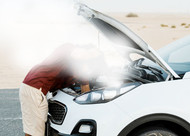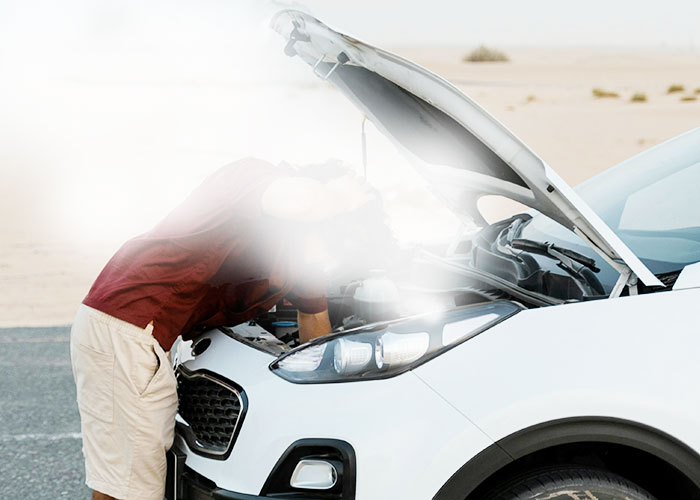Why Is My Car Engine Smoking And What To Do?
24th May 2024
When you see smoke coming from your car engine, it's a clear sign that something is wrong. It’s important to pay attention to the engine smoke color, as it can tell you a lot about what might be going wrong under the hood.
In this article, we'll cover the specific reasons why your car engine is smoking and provide practical solutions for each scenario. Whether your car is emitting white, black, or blue smoke, we’ll guide you through the steps to diagnose and fix the issue of engine smoke. Keep reading to learn how to address this problem and get your car back in top shape.
Why Is My Car Engine Smoking?
Smoke from your car engine is a telltale sign that something isn't quite right. Addressing this early can prevent more severe problems down the road, ensuring your car stays reliable and safe.
Below are some of the issues that cause engine smoking:
- Leaking Head Gaskets: This problem can allow coolant to seep into the combustion chamber, leading to white engine smoke, which often indicates a serious issue requiring immediate attention.
- Defective Coolant Systems: Faults in the coolant system can cause the engine to overheat, producing steam or white engine smoke. This might include a failed water pump, a clogged radiator, or a leak in the coolant reservoir.
- Burnt Electrical Wires: Electrical faults can lead to the burning of insulation on wires, creating acrid, grey engine smoke. This is dangerous as it could lead to an electrical fire, damaging critical vehicle components.
- Worn Pistons: Over time, piston wear can lead to oil leaking into the combustion chamber, producing blue engine smoke during operation, especially noticeable when accelerating.
- Faulty Fuel Valves: Improper functioning of fuel valves can result in excess fuel burning in the combustion chamber, which emits black engine smoke and indicates a rich fuel mixture.
- Turbocharger Issues: If your car is equipped with a turbocharger, problems like a blown turbo can lead to smoke. A failing turbocharger might leak oil into the exhaust system, producing blue or grey smoke.
To effectively diagnose these issues, consider following these steps:
- Source: Inspect the engine and exhaust system to determine where the smoke originates.
- Color: The smoke's color can provide clues; white suggests coolant issues, blue points to oil, and black indicates excess fuel.
- Timing: Observe when the engine smoke appears—during startup, under load, or continuously.
- Overheating: Monitor the temperature gauge to see if the vehicle is overheating, which can be a telltale sign of several underlying problems.
Sometimes, you might notice what appears to be smoke, but it's actually water vapor. This is common on colder days when the exhaust system can emit visible steam, which is harmless.
What To Do If Your Car Engine Is Smoking and Suggests a Fire?
When your car engine is smoking and suggests a potential fire, it's critical to respond quickly and safely.
Follow below steps to navigate the situation:
- Stop the Engine: Immediately turn off the ignition to halt the combustion process, which may prevent further damage.
- Release the Bonnet: Pull the release lever, but avoid opening the bonnet if you suspect a fire to prevent feeding oxygen to the flames.
- Evacuate the Vehicle: Quickly and safely evacuate all passengers from the vehicle and move to a safe distance.
- Call for Help: Dial 911 to alert the fire services if there is evidence of a fire, and provide them with your location and the nature of the emergency.
- Warn Other Motorists: If it is safe to do so, signal to other drivers to avoid the vicinity around your car, potentially using hazard signs or road flares if available.
Taking these steps can help manage the situation safely while preventing potential injuries or further damage to your vehicle.
Engine Smoke Colors And Their Meanings
White Engine Smoke
White engine smoke can indicate that coolant is entering the combustion chamber, often due to issues like a leaking head gasket, a crack in the engine block, or a malfunction in the cylinder head.
Reason 1: Faulty Head Gasket
- The head gasket seals the combustion chamber, preventing coolant and oil from mixing. When it fails, coolant can leak into the combustion chamber and vaporize as white engine smoke.
- Head gasket repair should be handled to ensure your engine returns to optimal condition.
Reason 2: Cracked Engine Block
- Severe engine overheating can cause the engine block to crack, allowing coolant to leak internally.
- This repair is complex and often expensive, requiring professional assessment and possibly significant engine work or replacement.
Reason 3: Damaged Cylinder Head
- Similar to a cracked engine block, a damaged cylinder head can allow coolant to enter the combustion chamber.
- Repair usually involves machining or replacing the cylinder head, tasks best left to qualified mechanics.
Blue Engine Smoke
Blue smoke suggests oil burning in the combustion chamber, typically due to worn engine components like piston rings, valve seals, or cylinder walls.
Reason 1: Worn Piston Rings
- Piston rings seal the combustion chamber from the oil pan. Over time, they can wear out and allow oil to seep into the chamber and burn, producing blue engine smoke.
- Replacing piston rings involves dismantling the engine, a job for a skilled mechanic.
Reason 2: Damaged Cylinder Head
- Similar to a cracked engine block, a damaged cylinder head can allow coolant to enter the combustion chamber.
- Repair usually involves machining or replacing the cylinder head, tasks best left to qualified mechanics. This can be your next challenging DIY profile.
Grey Engine Smoke
Grey engine smoke can be tricky as it might indicate either burning oil or an overly rich fuel mixture, and could involve a variety of engine issues.
Reason 1: Turbocharger Oil Leak
- In cars with turbochargers, oil leaks can occur in the turbo system, leading to grey smoke.
- Turbocharger repairs or replacements are complex and should be conducted by professionals familiar with high-performance engine components.
Reason 2: PCV Valve Failure
- The Positive Crankcase Ventilation (PCV) valve controls the flow of combustible gases back into the engine. If it fails, it can cause oil to enter the intake manifold, leading to grey smoke.
- Replacing a PCV valve is generally straightforward but should be done correctly to avoid future issues.
Black Engine Smoke
Black smoke from your engine is typically a sign of an overly rich fuel mixture, where too much fuel is being burned. This can be caused by various issues ranging from fuel system malfunctions to air intake restrictions.
Reason 1: Faulty Fuel Injectors
- Fuel injectors are responsible for spraying fuel into the engine in a fine mist. If an injector is stuck open or leaking, it can deliver too much fuel, resulting in black smoke.
- You can fix this problem by cleaning the fuel injector or by replacing it.
Reason 2: Dysfunctional Carburetor
- In vehicles with carburetors, an improperly adjusted or failing carburetor can cause too much fuel to flow into the engine, leading to black smoke.
- Adjusting or replacing a carburetor requires precise tuning, which should be performed by an experienced technician.
Reason 3: Blocked Air Filter
- A clogged air filter restricts the flow of air into the engine, upsetting the air-to-fuel ratio. This often results in excessive fuel relative to the amount of air, producing black smoke.
- Replacing the air filter is a simple maintenance task that can restore the proper air-to-fuel ratio and eliminate black smoke issues.
Exhaust Smoke Colors And Their Meanings
White Smoke
White smoke from your exhaust on cold days is typically harmless condensation. However, persistent white smoke in warm weather suggests serious issues like a cracked engine block or a blown head gasket, requiring immediate professional attention.
If white smoke smells sweet, it likely means coolant is burning, signaling potential overheating and severe engine damage. It's crucial to have a mechanic inspect and repair your vehicle promptly to ensure safe operation and prevent further damage.
Blue Smoke
Blue smoke from your exhaust indicates oil burning in the engine, commonly caused by worn piston rings or valve seals. It’s essential to check your oil level and consult a mechanic if you notice blue smoke during acceleration or engine startup to prevent further damage.
Persistent blue smoke reduces engine efficiency and increases oil consumption, harming the environment with excess pollutants. A mechanic should assess and replace any worn components to prevent costly future repairs and maintain engine performance.
Black Smoke
Black smoke from your exhaust suggests your engine is running too rich, meaning too much fuel is being burned. This could be due to a clogged air filter, malfunctioning fuel injectors, or a faulty fuel pressure regulator, leading to incomplete combustion.
To address black smoke, consider cleaning or replacing the air filter, repairing or replacing fuel injectors, and fixing the fuel pressure regulator. Quickly resolving these issues prevents fuel waste and potential engine damage, and regular maintenance can detect problems early, keeping emissions clean.
Grey Smoke
Grey smoke from your exhaust can signal various issues, like burning oil or a rich fuel mixture, and in turbocharged engines, it may indicate a turbocharger oil leak. Monitoring oil and fuel consumption can help identify the problem.
Due to the complexity of the causes behind grey smoke, utilizing professional diagnostic tools and expertise is crucial for accurate identification. Regular servicing and prompt attention to exhaust smoke are key to preventing long-term damage and maintaining engine performance.
Sign Up With JB Tools And Get A Chance To Save On
Sign up with JB Tools today and unlock exclusive savings on your next purchase. Join our community to receive special offers, updates on new tools, and promotional discounts directly to your inbox. Take advantage of this opportunity to save big on high-quality tools and equipment. Register now to start enjoying the benefits immediately!
FAQs
1. Can I drive my car if the engine is smoking?
Driving a car with a smoking engine is generally not advisable. The smoke can indicate serious issues such as oil leaks, overheating, or combustion problems, which could lead to more severe damage if not addressed. It's best to safely pull over and consult a mechanic to diagnose and fix the issue to prevent further damage to the vehicle.
2. Does low oil cause smoke?
Low oil in itself does not directly cause smoke, but it can lead to engine damage that results in smoke. If the engine oil level is too low, it can cause increased friction and overheating of engine parts, potentially leading to oil burning off and emitting smoke. Therefore, maintaining proper oil levels is crucial to prevent damage and smoking.
3. Why is my engine smoking but not overheating?
Your engine might be smoking without overheating if there's an issue like oil leaking onto hot engine parts or a problem with the turbocharger, such as oil seals leaking. These scenarios can produce smoke as oil burns off, without necessarily causing the engine's overall temperature to rise to an overheating state. It's important to address these issues promptly to avoid further engine damage.
4. Can I drive my car with white smoke?
Driving with white smoke is not recommended as it typically indicates a coolant leak into the combustion chamber, often due to a blown head gasket, a cracked engine block, or a damaged cylinder head. These are serious issues that can lead to major engine damage or failure if not addressed promptly..
5. How much white smoke from exhaust is normal?
A small amount of white smoke from the exhaust when starting your car, especially on cold days, is normal and usually just condensation evaporating. However, continuous white smoke during normal driving conditions is not normal and suggests underlying issues.


